Inspired for an Adventure? Check out Beef Stroganoff - Pouch and Beef Stew - Pouch
Free Ground Shipping On All Orders
Over 2,100 Reviews
Add description, images, menus and links to your mega menu
A column with no settings can be used as a spacer
Link to your collections, sales and even external links
Add up to five columns
Add description, images, menus and links to your mega menu
A column with no settings can be used as a spacer
Link to your collections, sales and even external links
Add up to five columns


Winter serves up frosted-over beauty, for sure, but also plenty of risks. The season doesn’t look kindly upon outdoors people who come to it unprepared or disrespectful of its rigors. Freezing temperatures, wind, moisture, and fatigue can turn minor problems into life-threatening emergencies faster than many people expect.
Winter wilderness survival isn’t about toughness or luck. It’s about understanding your priorities early, staying deliberate with every decision, and knowing how to protect yourself from cold and energy loss. We put together practical winter survival information and tips to help you make it through a cold-weather emergency safely, including:
- Understanding the priorities of winter survival
- Shelter strategies for cold environments
- Choosing a safe shelter location
- Fire and heat management
- Clothing and moisture control
- Food, water, and energy needs in winter
- Traveling safely through winter terrain
- What to do if you’re stranded in a vehicle
- Building a reliable winter survival emergency kit
Whether you’re heading out on a planned winter camping trip or find yourself in an emergency situation, be prepared before venturing out into the white stuff!
What are the Basics of Winter Survival?
Whether you’re lost on foot in the frozen outback or stuck in a car on a snowed-in road, the essential elements of cold-weather survival are the same. You need to stay warm and dry, which means finding or making a shelter and creating a heat source. These need to be your first priorities, as you have to create an environment in which you can hunker down till help arrives or conditions allow you to get to safety. Frostbite and hypothermia can set in quickly if you don’t, especially on exposed skin like fingers, toes, ears, and the face. In extreme cold or strong wind, frostbite can develop in minutes.
Vehicle-related emergencies carry additional danger, particularly carbon monoxide poisoning if exhaust pipes become blocked by snow.
Effective winter survival comes down to a clear order of priorities:
- Stay warm and dry to prevent hypothermia and frostbite
- Insulate yourself from the ground, where heat loss is fastest
- Establish shelter early, before fatigue and cold take hold
- Maintain energy and hydration to support body heat and decision-making
- Make yourself visible for rescue whenever possible
Surviving in the winter wilds also means eating and drinking regularly to maintain your energy and regulate your body temperature.

Winter Survival Shelter
Shelter is often the single most important factor in winter survival. Protecting yourself from wind, snow, and moisture slows heat loss and creates a stable environment where you can rest, eat, and regain body warmth.
Can You Use a Tent in Winter Conditions?
Yes, but it must be one built for the cold conditions. If you’re a winter recreationist, you’ll want a four-season/mountaineering tent. You can get by with a three-season tent in some climates and during shoulder seasons, but skiers, snowshoers, climbers, winter backpackers, and other trekkers out and about in the depths of winter need a stronger, better-insulated shelter up for the demands of severe temperatures and biting winds.
To maximize warmth and comfort:
- Pack down and level the snow to create a firm sleeping platform
- Make it flat by stomping and grading it with snowshoes, skis, or anything else on hand
- Avoid pitching directly on loose snow, which will freeze unevenly overnight
- Secure guylines with anchors such as buried stakes, branches, or rocks
- A properly rated sleeping bag and insulated ground layer are key to retaining body heat
A stable tent setup improves sleep quality and conserves energy, both of which are critical for winter survival.
Choosing the Right Location for Your Shelter
Where you put up your tent or build your shelter can dramatically affect your ability to stay warm and safe.
- Avoid valley bottoms, ravines, and canyon mouths where cold air naturally pools
- Stay clear of avalanche paths and slopes loaded with snow
- Use natural wind breaks such as tree lines, terrain folds, or rock features
- Avoid exposed ridgelines where wind accelerates heat loss
- Check overhead hazards like unstable snow, cornices, or dead branches
Thoughtful site selection reduces wind exposure, improves heat retention, and lowers overall risk before you even begin building.
In their tried-and-true classic Mountaineering: The Freedom of the Hills, the Mountaineers organization suggests digging a foot-deep pit in front of your tent door and within the vestibule for the purposes of comfortably putting on and taking off boots as well as cooking during inclement weather.
Emergency Shelter Options Without a Tent
If you’re caught in an emergency situation without a tent, you’ll need to build your own shelter. One of the easiest and quickest techniques is to make a snow wall: The United States Marine Corps recommends building a horseshoe-shaped rampart at least three feet high, the open end facing downwind. You can reinforce the wall with branches or ski/trekking poles, and roof it with a tarp or poncho.
Other options include snow caves (which any mountaineer, in particular, should know how to construct), igloos, fallen-tree bivouacs, and snow trenches.
Proper ventilation is extremely important, and snow shelters must be reinforced and monitored to prevent collapse.
In winter conditions, controlling wind and moisture often preserves body heat more effectively than fire alone. Once you have shelter, every other survival task, such as eating, resting, hydrating, and signaling, becomes safer and more manageable.

Fire and Heat Management
Fire-starting materials should be a part of your emergency outdoor supplies at any time of year. In a waterproof container, pack tinder—for instance, a plug of dryer lint, or little strips of rolled-up newspaper bound by rubber bands—as well as several means of sparking flame: matches, a lighter, and a flint and striker.
Natural sources of tinder include dried moss and leaf litter, reserves of which you can sometimes find sheltered under the low-hanging boughs of a densely branched evergreen. Around a generous heap of tinder, build a teepee of small twigs and then kindling of small branches. Light the tinder and gently but steadily blow into it to build up the flames. Add larger wood once the kindling catches.
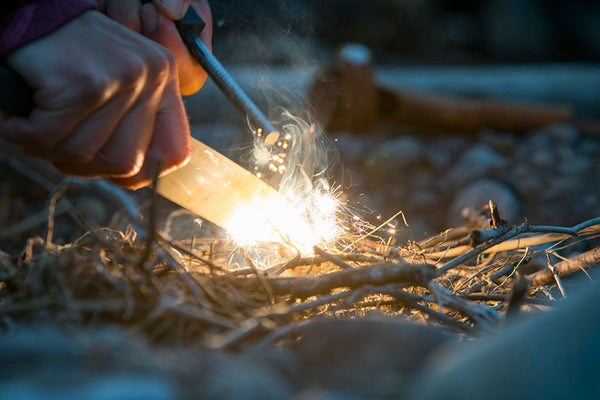
Clothing and Layering for Cold Weather Survival
Proper clothing is essential for cold-weather survival. The goal is to regulate body temperature while keeping moisture away from your skin.
- Base layer: Long underwear made of something like polyester or merino wool
- Insulating layer: Fleece or down traps warm air and provides insulation
- Shell layer: A waterproof and windproof outer layer protects against snow, rain, and wind chill
Wear wool socks, a neck gaiter, and a hat; pack a balaclava so you can protect your face against frostbite if temperatures really drop or winds kick up.
If you’re hanging out at camp or stopping along the trail, bundle up: Put a puffy jacket at the top of your pack so you can easily pull it on. If you’re traveling, strip to your midlayer or baselayer to avoid working up too much of a sweat: Drenched in perspiration, you’re vulnerable to hypothermia. Cut down on sweat and evaporative cooling by putting a vapor barrier—say, a plastic bag—over your socks.
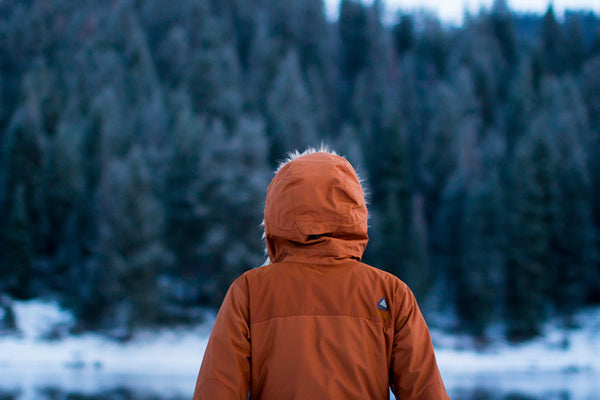
Food and Water Considerations
Breaking trail, building shelters, gathering firewood, and winter weather survival demand constant energy. Maintaining body heat alone burns calories at an accelerated rate. Eat frequently and prioritize high-calorie foods such as nuts, cheese, salami, chocolate, and other fat-rich options.
Hot meals offer both calories and psychological comfort. Freeze-dried options, like Mountain House meals, are especially effective in winter, conserving fuel while delivering dense nutrition. They simply require water, preferably hot, to rehydrate.
Dehydration’s a sneaky threat during winter survival camping. Melting snow’s a go-to option for obtaining drinking water, but if you can find ice, that’s a better source, given its higher moisture content. Remember to boil or otherwise disinfect that snow or ice meltwater before using it for drinking or cooking. Besides using a cooking container over a stove or campfire, you can also melt snow or ice by packing it within a t-shirt or plastic bag, tying that parcel to a tripod of branches near a campfire, and placing a container underneath to collect the drips.
For extended stays, establish a protected cooking area shielded from the wind so you can prepare food and water safely and efficiently. Drinking warm water can also help maintain body heat and boost morale in cold conditions.
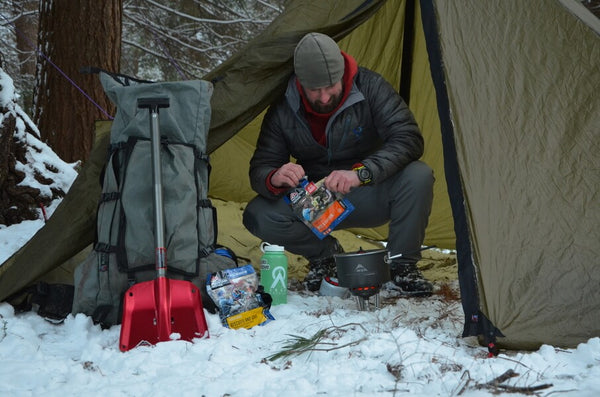
A Few Tidbits on Backcountry Travel in the Winter
Snow-covered landscapes hide obstacles, require slow movement, and demand more calories with every step, so travel decisions should be made carefully and deliberately.
When possible, choose ridgelines, windward slopes, or forested areas, which often have firmer snow and offer easier passage. Leeward slopes and valley bottoms tend to collect deeper snow, making travel more exhausting and increasing avalanche risk.

Avalanche Awareness
Avalanches are a serious winter hazard and can occur on surprisingly moderate slopes, especially after heavy snowfall, strong winds, or rapid temperature changes. Avoid traveling below steep or snow-loaded slopes and stay out of terrain traps where snow can funnel and pile up. Watch for warning signs such as cracking snow, recent slides, or collapsing layers, and adjust your route immediately if conditions feel unstable. For those traveling intentionally in avalanche-prone areas, the National Avalanche Center provides online resources that are well worth reviewing before heading into the backcountry.
In many winter survival situations, movement is not always the safest option. Poor visibility, deep snow, and fatigue increase the likelihood of accidents and poor decision-making. When conditions are uncertain, limiting travel and focusing on shelter and signaling may be safer than pressing forward.
How to Survive a Winter Storm in Your Vehicle
Many a winter-survival situation doesn’t play out on foot in the white wilderness, but in your car along a snowbound roadway. Your vehicle can be stranded anywhere, after all, including right on the Interstate. Let’s say, though, that you find yourself stuck in a blizzard on a remote road (for instance, one you’re taking to a cross-country ski or snowshoe trailhead). What do you do?
- Stay with your vehicle. You have a much better chance of being found if you stay put, and your car provides immediate shelter from wind, snow, and blowing ice.
- Make yourself easy to find. Tie a brightly colored cloth to your antenna or door handle so it is visible from a distance. At night, keep the dome light on to help rescuers locate you in low visibility. If conditions allow, stomp out “S.O.S.” or “HELP” in the snow nearby or form the words using tree branches in an open area visible from above.
- Manage heat without wasting fuel. Ready.gov recommends running the engine for about 10 minutes every hour to stay warm while conserving gas. While the engine is running, crack a downwind window slightly for ventilation. Check your exhaust pipe regularly to ensure it remains clear of snow, as a blocked exhaust can cause carbon monoxide to build up inside the vehicle.
- Insulate your body. Use extra clothing, hats, gloves, and blankets from your vehicle survival kit to retain heat. In extremely cold conditions, floor mats, seat covers, and spare clothing can provide additional insulation when wrapped around your legs or torso.
- Prepare before winter travel. Before heading out on a winter road trip or an outdoor adventure, make sure your vehicle is in good working order and stocked with emergency supplies. Always share your route and itinerary with someone back home so they know where to look if you do not arrive as planned.
What Do You Add to a Winter Survival Emergency Kit?
In your vehicle and in your pack, you should have the essentials of wilderness survival on hand at all times in case you run into a sticky—err, snowy—situation.
- Fire starting tools. Carry multiple ignition sources such as waterproof matches, a lighter, and a ferro rod. Fire provides warmth, allows you to melt snow and purify water, cook food, and signal for help.
- High-calorie food. Pack calorie-dense foods like nuts, energy bars, chocolate, or cured meats that are easy to eat in cold conditions. Mountain House emergency kits are especially good for this type of situation since they offer simple preparation, balanced nutrition, and a long shelf life.
- Drinking water and purification supplies. Carry insulated water bottles when possible and include purification tablets or a filter. Snow and ice must be melted and treated before drinking, and dehydration is common in cold environments, even when you do not feel thirsty.
- Extra insulation and clothing. Include spare socks, gloves, a warm hat, and an insulating layer.
- Emergency shelter materials. A lightweight tarp or emergency blanket can provide quick protection from wind and snow.
- Lighting and power. Headlamps or flashlights with extra batteries are essential during short winter days and long nights.
- Signaling devices. Carry a whistle, signal mirror, and brightly colored fabric.
- First aid kit. Include supplies for cuts, blisters, sprains, and cold-related injuries. Minor injuries become more serious in winter when the cold slows circulation and healing.
- Navigation and communication tools. A map, compass, and charged phone or emergency communicator help you stay oriented and call for help if needed.
Keeping these items accessible rather than buried deep in your pack or trunk makes them far more useful in an emergency. After all, winter survival rewards preparation, awareness, and self-reliance.

Add Mountain House to Your Emergency Survival Kit
Building your winter survival skills starts with preparation and dependable gear. Shelter and warmth matter, but reliable fuel for your body is just as important.
Mountain House meals are built for cold weather and emergency situations. They are lightweight, easy to pack, simple to prepare with water, and provide the calories and nutrition you need to stay warm and focused. With one of the longest shelf lives in the industry, Mountain House freeze-dried food is a reliable and smart addition to any winter survival or vehicle emergency kit.
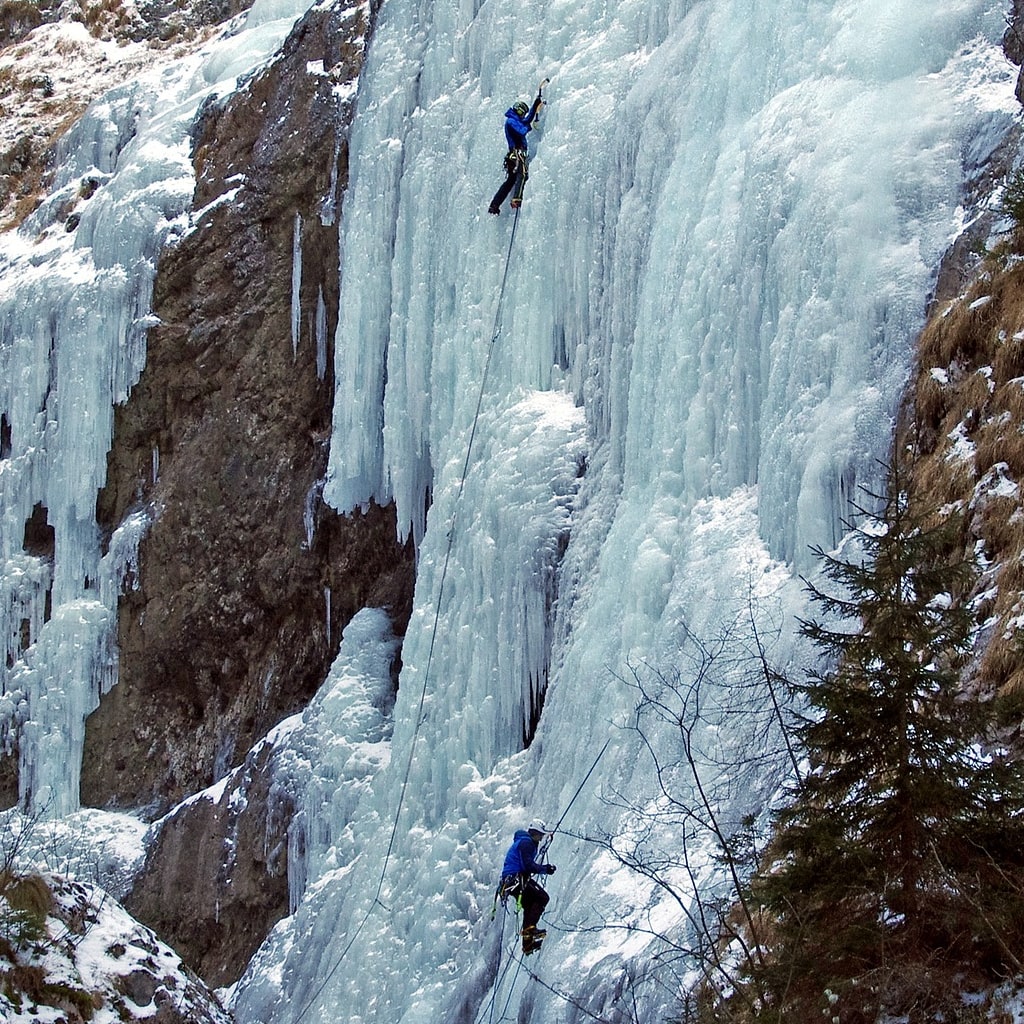
A Beginner’s Ice-Climbing Guide: How to Get Started
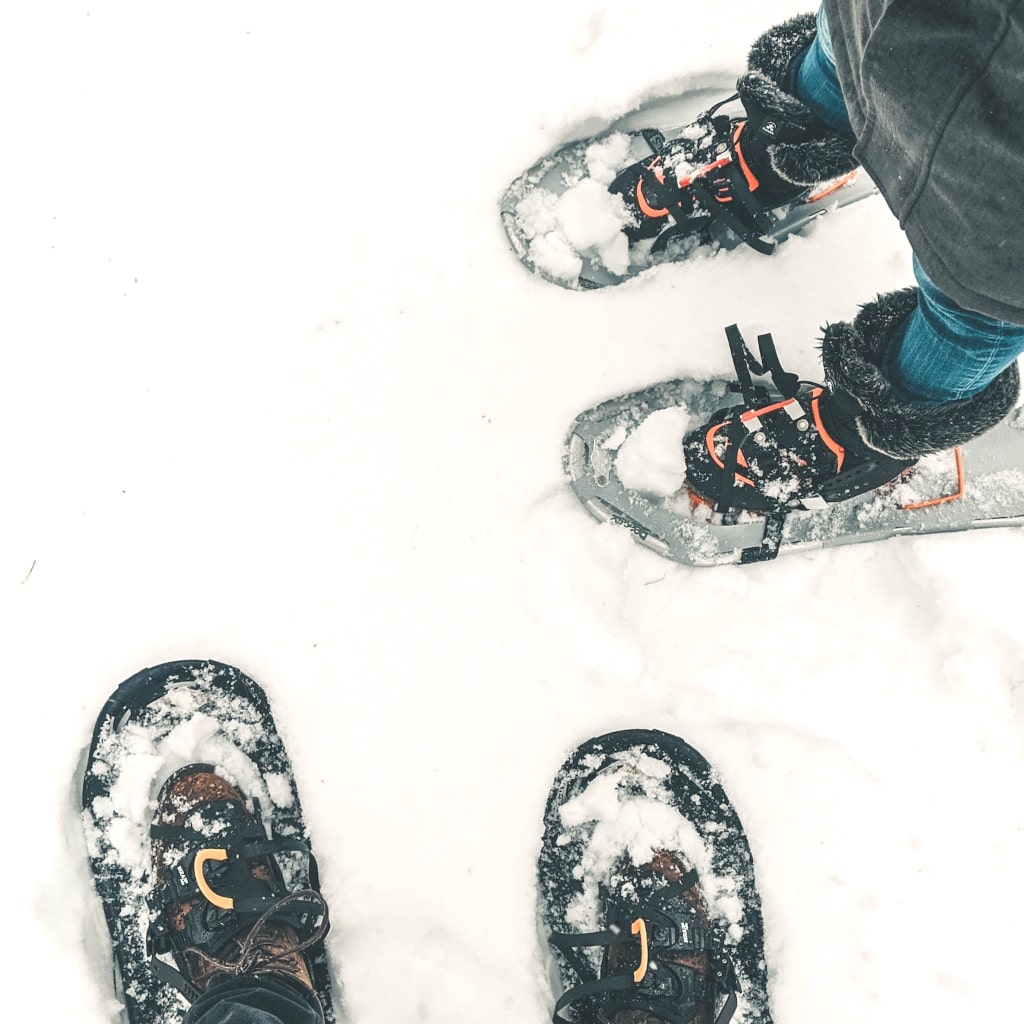
15 Best Places To Go Snowshoeing in North America This Winter


Stay Hungry for Adventure
Sign Up for Delicious Outdoor Meals & Exclusive Offers!
By clicking ‘Join Now’, I agree to the Terms of Service and Privacy Policy.


Join the adventure
©2026 Mountain House — All Rights Reserved.
Your Cart is Empty
Continue ShoppingYour Cart
Subtotal
$0.00
EXPRESS PAYMENT METHODS AVAILABLE IN CHECKOUT
Taxes and Shipping Calculated at Checkout
Your ExpertVoice deal.
$[Deal Price]
$[Original Price]
Discount applied at checkout.
On sale now — lower than your ExpertVoice discount.
Not eligible for ExpertVoice discount.














